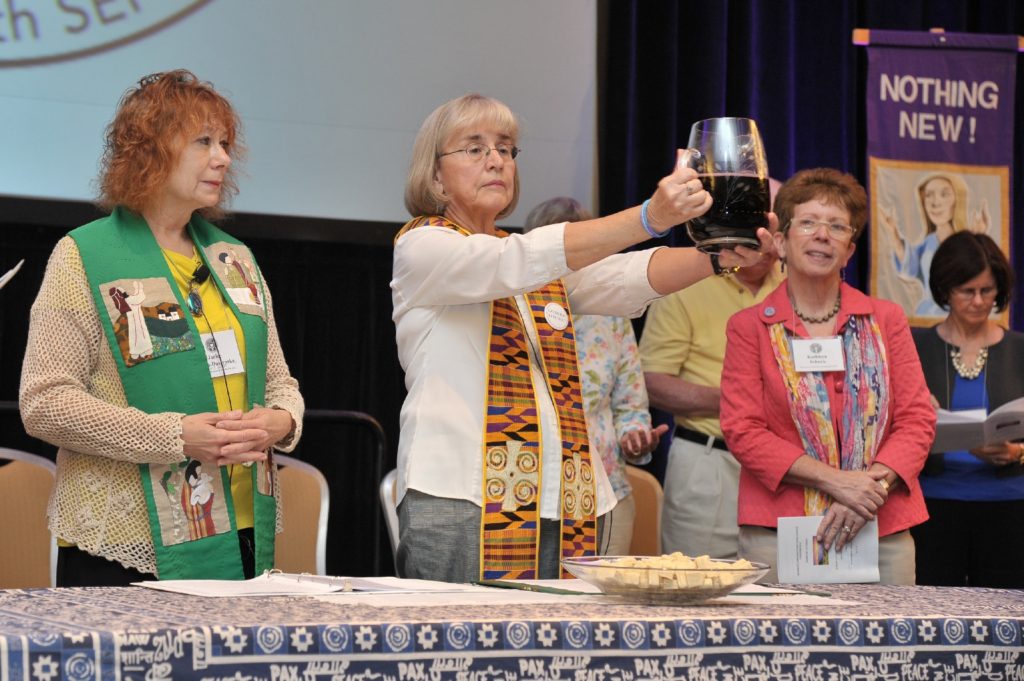Synod or Canon Law?
On April 30, 2021, my colleague Ellie Harty, co-editor of Equal wRites (the publication of the Southeastern Pennsylvania Women’s Ordination Conference), asked me to write an article on the 2022 Vatican Synod. I agreed.
On May 21, 2021, the Vatican announced that Pope Francis has changed the date of the Synod to October 2023 and presented a completely new process involving YOU. Francis’s ecclesiastical imagination means spontaneity in a place where that does not happen often. (I’m glad I postponed writing!) And I’d guess that Cardinal Joe Tobin, who spoke on Synodality on May 3, 2021, knew what was coming. According to Gerard O’Connell in America, Francis approved the plan April 24, yet most news outlets expressed surprised at its structure and contents.
But the surprises were not over. On June 1, 2021 the Pope Francis issued a “New Book VI of the Code of Canon Law, PENAL SANCTIONS IN THE CHURCH.” I would say this document was prepared by the non-spontaneous forces in the Vatican! Most news outlets reported on the careful revision of penalties for offenses of abuse of children and other vulnerable people. Accountability in this area is welcome, as it is in the area of economic crimes, mentioned by NPR.
Lumped in with these crimes and punishments is the following:
Can. 1379 — § 3. Both a person who attempts to confer a sacred order on a woman, and the woman who attempts to receive the sacred order, incur a latae sententiae excommunication reserved to the Apostolic See; a cleric, moreover, may be punished by dismissal from the clerical state.
WOC’s Executive Director, Kate McElwee, immediately responded:
Pope Francis’ June 1 changes to the Code of Canon Law (Book VI) on offenses and punishments fail to correct the mischaracterization of the “grave crime” of women following their authentic vocations to ordained ministry. While not new, the revised canon 1379 is a painful reminder of the Vatican’s patriarchal machinery, and its far-reaching attempts to subordinate women.
The consistency of the Vatican’s misogyny does not diminish its power to shock and appall the faithful, who can distinguish between the actually “grave crime” of sexual abuse of a child and the fulfillment of a priestly vocation to serve the People of God.
At a time when Pope Francis has convened a second commission to study the diaconate for women, we lament the reinforcement of any barriers against women answering their vocation to “sacred orders,” which includes the diaconate…
The continued exclusion of women from holy orders contributes to the very culture of abuse that has failed and harmed so many.
The cover document to the new canon laws, Apostolic Constitution “Pascite Gregem Dei,” is not yet available in English, “Tend the Flock of God.” The summary in Vatican News quotes Pope Francis saying twice – maybe more – that the point of it all is avoiding scandal. Does he not understand the difference between the scandals of abuse by clerics and cover-ups by bishops and the sacramental, pastoral service by women priests? They are indeed “tending the flock of God.”
The scandal is establishing roles for women – catechist, acolyte, lector – that are subordinate to an elaborate male hierarchy. It is the most visible enactment of the sin of complementarity, sexism masquerading as theology, continued discrimination masquerading as progress.
ABC.net quotes canon law professor Kurt Martens, “Unlike civil authorities, what is the power of the church to enforce penalties she ultimately chooses?” Most of the ordained women I know minister to intentional Eucharistic communities, which are not going to remove them or impose any of the other latae sententiae penalties. The Spirit will continue to inspire.
Most of the world recognizes the equality of people of all genders to work and serve according to their talents. Can the Roman Church bear the scandal of doing that halfway, with visible appointments without final authority?
McElwee’s statement concludes: “A synodal church demands the full participation of women as equal partners in ordained ministry, and nothing less.”
Does this allow me to transition to my previously-prepared paean to the Synod? So many of Francis’s goals are so good. Why is he so blind to the call of women?

*******
The most startling thing about the Synod that I read is from Massimo Faggioli in La Croix International, reprinted in NCR: “At that point, [October 2023] Francis will be almost 87 years old. By that age, all of his predecessors on the Chair of Peter had either died (with the exception of Leo XIII) or had resigned (such as Benedict XVI and Celestine V).
“And if, God forbid, the Jesuit pope should not make it to 2023, this ‘synodal process’ will have already begun. It’s his insurance policy against the possibility that his pontificate will be promptly archived as a quick break before another pope returns to the status quo.”
Quite a “long game,” indeed. Is this to be Vatican III? Think how unanticipated Vatican II was.
And how does this new process involve YOU?
Christopher Lamb in The Tablet provides a succinct summary: “Rome is asking every diocese across the world to begin the first phase of the process on 17 October this year.
Each local church will be sent details for a consultation and listening process that must last until April 2022 when a diocese will be required to submit proposals to their bishops’ conference.”
The Pope made clear that he means all the people, “from the bottom up.” In a welcome to the Italian bishops that Cindy Wooten of CNS reports, he said it must begin with “the smallest parish, the smallest diocesan institution.” So you can start thinking now about what you want to say.
Francis continued, “This will require patience, work, allowing people to talk so that the wisdom of the people of God will come forth because a synod is nothing other than making explicit what Lumen Gentium said: The whole people of God — all of them, from the bishop on down — is infallible in belief. They cannot err when there is harmony among all.” Do you take a deep breath at the audacity of this vision reappearing fifty years after Vatican II?

So what will be talked about? “The planned subject — ‘For a synodal Church: communion, participation and mission’ — remains the same but the new means adopted are now more intrinsically suited to such a topic,” as Michael Sean Winters says. He continues, “What matters now is that the pope has invited the universal church to consider a different way of organizing itself and meeting its challenges. The model of papal monarchy that has been so pronounced in the past two centuries has served the universal church exceedingly well, but the times in which we live, and the sociocultural realities in which the church must evangelize, demand a new approach. Pope Francis is pointing the way.” The monarchy model was on the way out after Vatican II, in my opinion, but Paul VI, grasped at it when he felt threatened, and John Paul II and Benedict XIV never let it go.
I have second thoughts about the conclusion I prepared before, a reflection that affected me profoundly. A British priest-professor, Thomas O’Loughlin, wrote a Pentecost essay on synodality in La Croix International. At another level, entirely, the theological, he writes on the gifts of the Holy Spirit: “it is useful to remember that the Spirit is simultaneously the giver of diversity – and that in divine economy that unity and diversity are not in contradiction. It is this richness that can be the richness of a synodal Church.”
O’Loughlin finds diversity in all creation, and finds its scriptural source in the variety of talents in 1 Corinthians 12:4-30. He asks “How many human beings are there: each clinging to their individuality, distinctiveness, and identity.” “Every tyrant in history has eventually sought to destroy differences of opinion – in everything from politics to art – and then usually sought to eradicate humans that appeared too different from his image of perfection. In contrast, the Spirit produces diversity upon diversity, and we can marvel and rejoice in the Spirit’s creativity.” Let us examine our own consciences – or really, I examined mine about valuing the differences among those I encounter every day.
O’Loughlin goes on to consider the Church: “Diversity has a bad history in Christian practice…it’s fragmentation, schism, heresy.” Characterizing the “Tower of Babel myth” as one in which “sin splits and destroys unity,” he wants us instead to embrace the “myth of Luke,” in which “the Spirit, even in a miracle of uniting the nations, values diversity.” Each speaks in his own tongue, each hears in his own language, words we know so well.
And yet, O’Loughlin concludes, rather than the miracle of Luke, humans try to synthesize.
“We see the same tendency in among those who are fearful of synodality: they praise it, but then imagine it can be predictably packaged.
“However, such synthetic formulae almost assume that the mystery of the divine can be comprehended or neatly wrapped up. Rather we should live with the staccato insights and not seek to reduce them to what seems to fit our minds.
“The Spirit is unifying. The Spirit is diversifying. The Spirit can be seen in any number of other ways. The Spirit is, indeed, infinite.”
I find this article inspiring as I read about this synod, and as I think about what happened at Vatican II. Perhaps these planners have developed a process that will free, not confine, the Spirit.
Next week I will write about the Synod’s people and the rest of the process, as well as some more worldly critiques. Keep in mind O’Loughlin’s comment on synthesis.
I will also update the new Canon Law changes. The Vatican culture wars have rarely been so in evidence, and a “cancel culture” approach to ordained women still enrages.


2 Responses
Thanks for providing a synodal context to help us calm down after the outrageous display of patriarchy tacked on to the end of what was covered in media as a strong response to the sexual abuse scandal in the church. The bulk of that document, admitting that sexual abuse of adults by other adults in positions of power in the church, is wrong and should be penalized within the church, focused on real sins which should have real consequences. Interestingly, the gender of the victim, or even that of the perpetrator, does not seem to affect the definition of that sin. To then equate such conduct with the “sin” of honoring women’s equality by enabling fully-trained women called to the priesthood to answer that call and serve their church and its people seems especially jarring. You give us some hope that through the discussions leading to the 2023 synod, we will see a groundswell of support for women’s ordination that will lead to further movement away from monarchy toward a communion of all the faithful, led by people who represent their full diversity.
The VFCW square image is good, but we need one that says:
SEVEN SACRAMENTS FOR WOMEN